My first week back on the island I had the privilege to meet Albert Shepard, Curator at the Whale Museum. Albert is currently working on cleaning the bones of the recently deceased young female Southern Resident killer whale L112 (Sooke/Victoria) whose body washed up on the shores of Long Beach, WA this past February. I first learned of Sooke’s death just a few short days after the news broke. Ironically, I was in the midst of packing for the Beam Reach course. In the following weeks I read articles, watched necropsies, and thought about what could have possibly happened to this young, seemingly healthy whale. After arriving on San Juan Island in March for Beam Reach I learned a lot about the investigation into Sooke’s death. There are a number of theories out there as to the cause of death, but no one is really sure as to what happened to her.
The last few months of thinking about Sooke and learning about her death were pulled together into a momentous experience when I was able to see her beautiful skeleton laying out in the sunshine at Friday Harbor Labs. Spending two afternoons with Albert, just looking at the pieces of the skeleton come together was incredible. I have been in love with orca whales since I was five years old, and seeing the structure of an orca — what gives it shape and strength and the ability to swim — was mind-boggling. I wish that I could let all of you have the same experience of admiring L112’s skeleton in all of its beauty, and someday hopefully you will get the chance. The Whale Museum is working on a display in memory of L112 that will include her skeleton. Until then, I hope these pictures will give you an idea of how beautiful and intricate Sooke’s skeletal structure really is.
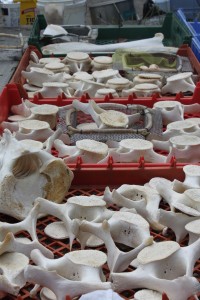
Vertebrae
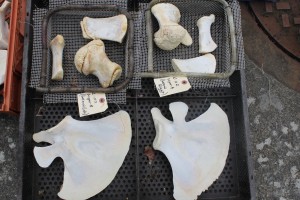
Scapula and other bones
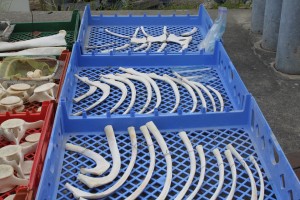
Ribs
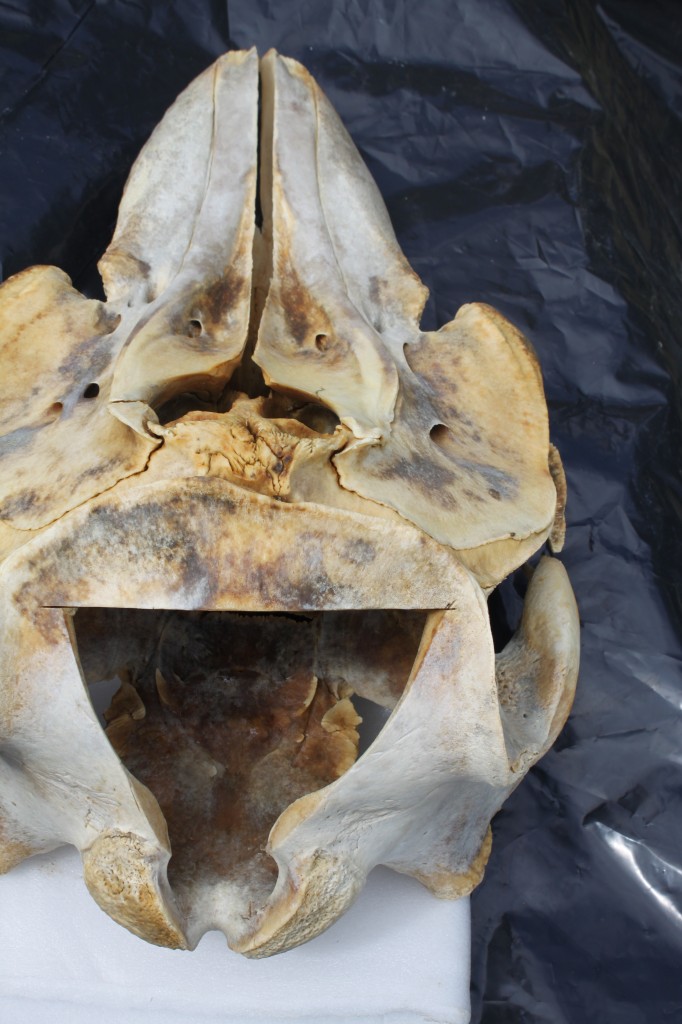
L-112 Sooke/Victoria skull
For more information on Sooke and the investigation into her death please go to the following resources:
Beam Reach blog
Center for Whale Research
http://www.whaleresearch.com/encounter_pages/2012/news_L112death.html
The Whale Museum
http://www.whalemuseum.org/programs/stranding%20network/Sooke.html
Read More
We did it! Beam Reach Class 121 survived almost four full weeks living aboard a catamaran, studying physical oceanography, underwater sounds, and the Southern Resident Killer Whales, and most importantly we did it together.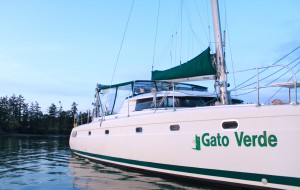
Our experience wasn’t just any regular research field experience. We were lucky enough to live aboard the Gato Verde, a glorious 42’ catamaran developed to be “Boat Greenâ€. Not only was our living experience pretty plush for field researchers, but we also learned how to live sustainably on the water while conducting our own individual research projects.
Although designing and conducting my own research project was academically challenging, living and working on the Gato proved to be a whole different kind of challenge. I learned to be very conscious of my own space and personal needs in a group dynamic, which I feel is one of the most valuable lessons I learned aboard the Gato. I also became very conscious of other things during our time at sea: my waste output as well as my classmate waste output; the state of the currents and tides at any given moment, our time on the water each and every day, and where all the good mooring spots are near Haro Strait. We monitored these various factors as well as other important boat factors every day before we planned our science activities during the daily morning meetings.
Monitoring Our Impacts
Each day we were assigned different duties in terms of boat maintenance and preparation for the day ahead. The student assigned to “systems†each day was required to monitor the battery and biodiesel usage of the Gato as well as our water and sewage levels. These four things are all very important to keep track of to keep the Gato running efficiently and also to be aware of our environmental impact. Sewage, also known as “black water†is a huge environmental concern for oceanic boaters. We monitor our sewage levels daily to ensure that we never run out of room in our holding tank. Anaerobic bacteria dominate our black water system and it is vital to make sure we do not run into a scenario where we dump this black water into the oceanic environment.
Part of living and, pooping, aboard a boat also means that you have to get all of the poop off of the boat, unless you want it to continue living with you, which wouldn’t be a pleasant experience for anyone. We were lucky enough to be able to “pump out†our sewage system three different times! When pumping out we usually had two students helping. A big hose with a suction cup at the end of it was attached to our sewage tank and then magic happens! Our waste, which now looks like brown, muddy water, begins to pump through this hose off of our boat. Although it sounds somewhat repulsive, it is actually kind of interesting. To make it easier on the students who were pumping out each time, we all took turns purchasing ice cream to share at the convenience store. Turns out that a little bit of ice cream made pumping out a favorite activity of Beam Reach class 121!
To decrease our sewage output aboard the Gato, we attempted to use “shore headsâ€, or toilets on land, whenever they were available. This meant if we pulled up to a mooring site and there was dock space available, we always went for the dock space, just because we could use the shore heads instead of the heads aboard the Gato, which means more time between pump outs!
Moving with the Wind
We had at least a week of beautiful, warm, and sunny weather during our time on Gato, which we took full advantage of by swimming in the Salish Sea multiple times! However, the wind wasn’t always on our side which prevented us from doing a whole lot of sailing this spring. During our 4-day cruise up to Cherry Point Captain Todd wanted to teach us how to tack. Of course we were all thrilled to sail, and move efficiently on the water using the wind. Tacking, also known, as “coming about†is a pretty common sailing technique that utilizes the wind by essentially sailing into the wind. The bow of the boat is directed through the wind, allowing the boat to change the direction that the wind blows into the boat. We learned how to tack on both the port and starboard sides of the boat. Tacking is one of my favorite sailing techniques that we learned because it really allowed us to actively take part in the sailing.
Helmsman
Sitting at the helm of the Gato was one of my favorite places to be, not only because it kept me from being sea sick all of the time, but also because I just love to drive boats. Manning the helm of the Gato was a really interesting experience, unlike driving any other boat. Being given the option of manually steering or using the autopilot function, I most always chose manual steering. It is a powerful feeling to be in charge of the direction of such a big vessel.
The End of the Voyage
As we pulled into Friday Harbor Labs for the last time, I felt an indescribable amount of emotions. I was relieved to have civilization, showers, Internet, warm food, all at my easy access, but somehow in such a short period of time I had grown accustom to life on the Gato. The small things that had at first posed challenges, such as waking up early, entering data on the boat, checking the navigational charts every hour, now felt apart of my every day life. The dock drew nearer as we were attaching the buoys to the boat with clove hitches, one last time. Once we were at the docks, we did a final set of bow and stern cleat hitches and began disembarking all of our personal and science gear. It was a bittersweet process, but rewarding on so many levels.
Wrapping up…
The most difficult aspect of the Beam Reach program was learning to live with so many people in such a small and mobile space like the Gato Verde. Yet, it proved to be one of the most rewarding experiences of my academic career. Saying good by my instructors and fellow students has actually been harder than the course itself and I know that no matter what else has come of this program, I have gained an extended family of sorts…I will miss them all, and our home on the water, dearly this summer.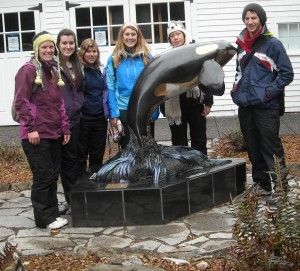
Read More
It has only been 3 days since the Gato Verde set off from the Friday Harbor Labs, but time flies when you are traveling on the water. In just this short period of time the Beam Reach class has become very familiar with the West Side of San Juan Island, especially our new home away from home, Snug Harbor. Snug Harbor is a small harbor on the West Side of the island, north of both Lime Kiln State Park and San Juan County Park (http://www.snugresort.com)
Now Snug Harbor has a comfortable familiarity, like pulling into the driveway of the home you grew up in, but upon our first arrival it was just a place to anchor for the night… And then we saw our first Snug Harbor Sunset. Although the first sunset at Snug Harbor may not have been the most spectacular of sunsets, it was special to us because it was the first of many we would experience. The West Side of San Juan Island has many magical characteristics, evergreen and deciduous forests that draw in your imagination, rocky cliffs dropping into the deep blue-green Haro Strait below, and of course the Southern Resident killer whales. All of these things I was expecting to encounter, but I never realized that I would be experiencing wondrous sunsets almost every night, and those sunsets became one of my favorite parts of cruising on the West Side of San Juan Island.
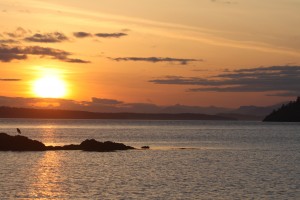
On top of the sunset Snug Harbor provides great wildlife viewing. One morning before breakfast we noticed a majestic bald eagle perched on the rock at the edge of the harbor. The skies behind him were blue and clear enough to see the mountaintops of Vancouver Island. I have seen many eagles, back in Minnesota, and on the island this spring, but this eagle was its own entity. He sat there on his perch, not even realizing the perfect photo opportunity he was giving us all. The scene looked like something off of a postcard or out of a wildlife magazine.
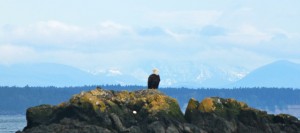
After an amazing first few days on the water and nights at Snug Harbor I look forward to the next couple of weeks. Boat life might be different and a little more difficult that life on land, but it is an adventure. Hopefully ours will include the Southern Residents soon!
Read More
If you missed this announcement on the MarMam listserve, it looks like a good fit for a Beam Reach alum. JASCO is a productive firm employing great acousticians, including Christine Erbe.
Position Description: Field SUPPORT SCIENTIST(S)
JASCO Applied Sciences is an international group of companies with over 30 years’ experience in the Oil & Gas, Renewable Energy, Marine Construction, Environmental, Oceanographic and Defense sectors. We are a world-leader in the science related to anthropogenic noise and its effects on marine life. JASCO has immediate openings for Field Support Scientist(s) in our Anchorage, Alaska office.
Position Overview
As a Field Support Scientist you will conduct scientific research programs in the field and at sea participating in the preparation, deployment, and retrieval of a variety of underwater acoustic instrumentation packages. This may require considerable travel worldwide.
Responsibilities
- Participate in scientific research studies at sea and in the field, possibly in remote locations
- Conduct routine maintenance, assembly and disassembly of oceanographic instruments and moorings
- Sea going support of oceanographic equipment deployments and recoveries
- Packaging of oceanographic instrumentation in preparation for shipping prior to deployment
- Unpacking and cleaning of oceanographic instrumentation after recovery
- Adherence to quality and health & safety policies and procedures
Required Qualifications and Experience
- Sea-going experience, ideally in support of scientific research, offshore oil & gas exploration or passive sonar operations
- Traditional Knowledge of the Alaskan Marine Environment
- Experience in the deployment, recovery and mooring of oceanographic instrumentation
- Keen attention to detail
- Excellent verbal and written communication skills
- Ability to work in a team environment maintaining focus on work quality
- Ability to perform physically and mentally demanding tasks
- Willingness and ability to learn
- Able to obtain/maintain a Marine Medical Certificate
- Able to travel internationally and to pass a government security clearance
Education
- Relevant Degree or Traditional Knowledge in Marine/Environmental Science, Physics or Biology
- Desirable: Knowledge of Underwater Acoustics and Noise Impact Assessment especially as they pertain to Marine Mammals.
- Desirable: Current Offshore Survival and Medical Certificates
- Desirable: Formal First Aid Training & Qualifications
Benefits:
- Competitive compensation package
Please send resume to careers@jasco.com
We thank all applicants for their interest, however, only those candidates being considered for an interview will be contacted.
Scott Carr
Chief Executive Officer
___________________
JASCO APPLIED SCIENCES
202 – 32 Troop Ave.
Dartmouth, NS, Canada, B3B 1Z1
T. +1.902.405.3336 ex. 1001
F. +1.902.405.3337
C. +1.902.691.0174
www.jasco.com
_______________________________________________
MARMAM mailing list
MARMAM@lists.uvic.ca
https://lists.uvic.ca/mailman/listinfo/marmam
Read More
I’ve always wondered how people in Medieval times sailed. I was told by the captain that it was much more difficult because they did not have motors and modern technologies such as GPS and weather forecasts. Sailors had to rely mostly on experience and observation. I find it really amazing. And I feel fortunate that we have the resources to sail safely through the oceans.
What makes the Gato Verde green? First of all, Gato Verde is the first Catamaran in the Pacific Northwest to make use of biodiesel. Gato Verde also uses LED lights on the boat, which are more energy efficient. The Gato uses lead-acid batteries, which are recyclable. These batteries only allow the Gato to go full-throttle for about 30 minutes (to be prudent). There are other types of batteries, namely nickel-metal and lithium. Lithium batteries are lighter and has twice the power of lead-acid batteries. To make the Gato more green, captain Todd has been considering adding solar panels to the boat.
On the boat, we make use of our resources sustainably. One good example is using sea water to wash dishes. It really worked for me as I usually prefer to rinse the dishes until they are spotless. I could do so without worry with sea water because we never have to worry about running out of sea water. The dishes are given a brief freshwater rinse after being thoroughly washed with sea water.
We learnt during a discussion the difference between “black water” and “grey water”. Grey water is waste water from washing. Usually, grey water from a boat is released directly into the open sea. It is worrisome to think about the potential harmful effects of surfactants on marine life. In the United States, boats are required to “pump out” their sewage at designated pump out stations. In Canada, however, boats can release their raw sewage into the open sea. This is worrisome. If sewage gets into freshwater sources, there is concern about contamination of drinking water. This is not a concern with sea water as we don’t drink sea water. However, by releasing sewage into the sea, we are releasing hormones, drug metabolites, and terrestrial pathogens into the marine environment. That can be harmful to marine life. Usually, raw sewage can be treated to remove harmful materials before being released into water.
In not so long a time we have learnt that ropes should not be called “ropes” but “lines” and “sheets” on the boat. Ropes the keep the sails in place are called “sheets”. Typically, a sailboat has a jib and mainsail. The jib is smaller than the mainsail, and its orientation is changed during tacking. Tacking is a sailing strategy where a boat sails zig-zag close reach, about 45 degrees to the direction of wind. Beam Reach is where a boat sails across the wind, approximately 90 degrees to the direction of wind. It is also good to remember the parts of the boat, especially when deploying the dock lines and fenders. The front of the boat is called “bow” and the back “stern”. On the boat, the direction to the front of the boat is “fore” and the back “aft”. With this special language, the boat seems to be a world of its own.
Read More

I once spoke to a seasoned wildlife biologist and he told me, “At least the species you are interested in are obvious and not elusive. It would be much harder to study elusive animals.”
He had a good point. At times, the day wore on without news of the whales, and even though we worked hard at taking physical oceanographic measurements, everyone grew worried that we were not going to get enough whale data. This is definitely something to keep in mind in future endeavours.
The emotions arising from “chasing whales” can sometimes get in the way. It’s frustrating, and it makes people anxious. One wonders, what can be done about it?
First of all, the team tried everytime to make the best educated guess of which spot in the Salish Sea would be the best spot to meet the whales, taking into consideration logistics such as biodiesel levels and whether there was a need to pump out or refill fresh water. Our Captain Todd had been our anchor the entire time, sharing with us his valuable knowledge and experience in seafaring. The navigation program OpenCPN gave us an edge in planning our routes.
The tides and currents played into it, too. Sometimes, the whales were sighted as far north as Point Roberts, and we had to consider the plausibility of making it to Point Roberts and back to San Juan Island for anchor in the evening.
As we did made our best effort to put ourselves in the best position, luck often played a part as well. When there is a lack of data, making a decision to chase whales that are a mile away became a dilemma. Nonetheless, despite these challenges, we had a good number of whale encounters. Some might think it too few, but in the end, the exhilaration of whale encounters, no matter how few or many there were, outweigh the frustration and as everyone got into the rhythm, everything brightened into a good day.
Read More
This has been one of the most incredible experiences of my life and has definitely changed my perspective of the world. Now I know this sounds super cheesy but it is so undeniably true. We just gave our final talks today and I never thought I would be able to so confidently talk about research to a room full of people. However, as soon as my presentation started I became so excited to share what I found with people that I was no longer nervous and really enjoyed it. If you have a strong desire to watch me talk way too fast for human hearing you can check out the recording from our talks today. With our presentations done all we have left are our final papers and then saying goodbye. I’m not sure which will be harder. I have met some amazing people on this journey and we have become a family of sorts. As I reflect on my time here I am amazed with the amount we learned but most of all the amount I changed as a person. Suddenly I’m eating vegetables like an adult, and starting to understand that I don’t know exactly what I want to do with my life. But I know that everything I learned during Beam Reach will help no matter where I go. I also know that I have made life long friends, taken part in incredible research in the Salish Sea and learned about myself along the way. So here’s to Beam Reach, for without it I would surely not be the person I am today, nor would I be headed in the direction that I am tomorrow
.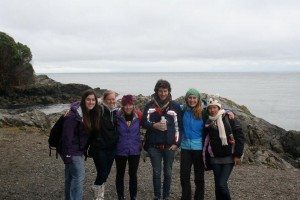
Read More
BLOG:
There is an old sailor tale that tells of a large ship one day caught in the middle of the Ocean. A large wave came over the side and knocked their anchor down into the depths of the ocean. No matter how much the sailors heaved and pulled they could not seem to pull up the anchor, and feared that if they pulled to hard they would make a hole in the bottom of the ocean, and drain out all the water. A brave sailor dove off the bow of the ship with knife in hand, ready to face whatever lay at the bottom of the sea. After a few tense minutes the sailor burst to the surface of the ocean and told the others that he had freed the anchor, and the ship was free to sail. After they had pulled him up onto the deck they asked him how he had freed the anchor. The sailor told them that a giant octopus had grabbed onto their anchor and was playing with it, but he had tied its legs into bowline knots, so it would never bother them again.
Although we didn’t encounter giant octopi on the Gato Verde (http://www.gatoverde.com/), I think this story reviles subtle truths about life out at Sea. First of all as a crew you have to be ready for anything whether it be a sea creature, or just the logistics of where to dock at night. Learning to be ready for anything at anytime takes a while to get use to, but like everything else we learned while on the Gato it seems to apply not only to sailing and science, to life.
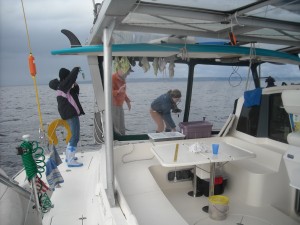
More Sailing!
One of the most important lessons I took away from the Gato was an understanding of what it takes to live sustainably. It is all too common to go through life unaware of the impact you are making, and the resources you are using. I feel that before my time on the Gato I was somewhat aware of my impact, and attempted to live sustainably, but I did not fully recognize the effect of everything I did. On the Gato we took measurements of the fresh water, sewage, and bio- diesel used. These are things that are easy to take for granted in every day life, but when living on a boat you start to realize just how much water you use, and sewage you produce. We had a water tank that held all our fresh water for dishes, drinking, and cooking with. Our water holding tank was on the port side of the Gato over the left hull. The water level was measured in cm and converted to liters and gallons. It was interesting to see how much water we used everyday. We still used a lot of water per person everyday, so it hard to imagine how much water we use daily when taking showers. The sewage tank was on the starboard side of the Gato near the bow. The sewage system was connected to the heads (bathrooms), which were on both the port and starboard side of the boat. Before the Gato I had not idea of how much sewage 8 people can produce, let alone a city, and how difficult sewage can be to deal with. Captain Todd explained the different types of holding tanks a boat can have, and the different ways to treat them. He had a type 3 system, which was an anaerobic system. He introduced a certain species of bacteria into his system that out competed the bacteria that make sewage smell. It was amazing to think that we had a tiny ecosystem on board the Gato with us. Who knew poop could be so fascinating!
In order to conserve bio-diesel we attempted to sail when the wind allowed. Although we didn’t get many opportunities to sail, it was a fun time when we did. Captain Todd taught us about the different points of sail: close-hauled, beam-reach, broad reach, running, and irons (no go zone). We got to steer the boat on our first cruse tacking down the Strait of Georgia. We learned how to sail right against the irons, without going into irons (60-50*) an ideal angle for sailing. We learned about how to let out the jib and main sail, and how to properly put both away.
As a class we also had to figure out our daily navigation. To do this we had to take a lot into consideration: the weather, sea state, tides, where the whales were, and where we would spend the night. At first this seemed to be a logistic nightmare, but after we created a routine for the navigator it became relatively easy. The hard part of navigating occurred when we had to make important decisions during the day, like if we were going to try and catch the whales.
Boat life is difficult, but extremely rewarding at the same time. Looking back my best memories of the boat involve sitting on the trampoline and just appreciating the sea that surrounded us.
Read More
Today is the last day of Beam Reach, and I don’t know how it went by so quickly. I came into this course ten weeks ago unaware of the amazing people I would meet, how much I would learn, and grow (unfortunately not height wise). So much has happened in ten weeks it’s difficult to sit down and distill it into words, but I will try. As class we were an unusual fit, we came in from completely different backgrounds, with different interests, from all over the world, but despite these differences we became inseparable.
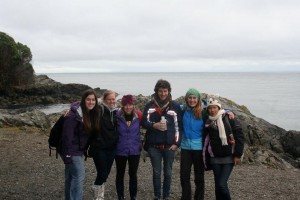 03 Skinny Love
03 Skinny Love
As time went on, and the class presented more challenges we never forgot to save time to laugh, and talk to one another. During stressful nights we would have the occasional dance party to help us get through our work in good spirits, but we also never forgot that we were at the labs to study whales.
The first time we encountered whales Robin, our lead professor, came running through the door of s1 out of breath to tell us their were whales in San Juan Channel. We dropped everything and ran as fast as we could down to the point to watch the whales. For many of us it was our first time seeing Orcas. It is an amazing feeling the first time you see a dark black fin slowly rising up out of the water. Its as if the whole world is centered on the magnificence and beauty of this one amazing animal. As the transients silently swam by it became clear to me at that moment why the work we did in this course mattered.
Since that first encounter with the whales I have never forgotten why I am here. I am sad that the course is coming to an end, but could not have asked for a better group of peers to spend the past 10 weeks with. They have inspired me to laugh, love, and learn everyday, and for that I am grateful.
Read More

on the boat
One of the more challenging aspects of living on a boat is having to cope with resource constrains, communication and mobility limitations. I don’t think I was fully prepared for this before I went on the boat. It only struck me after I had been on the boat for a few days that cell phone connection was intermittent in the Salish Sea, there was limited internet access, and we were not always docked.
This was not an easy lesson to learn and I realized that I had to think really far ahead in terms of planning my work. Although we generally had internet connection at Snug Harbor, the connection can get cut off when the boat moves, or sometimes even fail completely. I really had to budget my time and make full use of “internet timeâ€. Moreover, I could not rely on internet being available for the entire night.
Both Dr. Kodner and Dr. Buckman, our guest for two nights, were really helpful in helping me cope with this challenge. Most of the time, students use database (SQL) queries to filter and arrange data. This requires internet. When internet is not available, there is only Excel, which has a myriad of useful functions that make data analysis that much easier. Furthermore, Dr. Veirs has suggested that it’s possible to work with SQL as an offline application. That’s something!
Read More
















 Twitter
Twitter LinkedIn
LinkedIn Facebook
Facebook